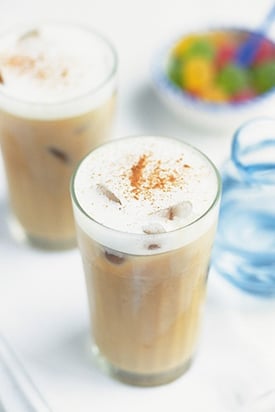-
Enhance Experimentation in RTD Tea and Coffee
By Vikki Nicholson-West August 19, 2016- Tweet
 Coffee and tea are popular day-to-day drinks and their desirability is on the rise with recent reports stating more consumers want a nutritious way to stay energized. Something as simple and nutritious as dairy paired with the possibilities in staple beverages can create successful beverages options worth further exploration.
Coffee and tea are popular day-to-day drinks and their desirability is on the rise with recent reports stating more consumers want a nutritious way to stay energized. Something as simple and nutritious as dairy paired with the possibilities in staple beverages can create successful beverages options worth further exploration.The rising popularity of ready-to-drink. The convenience, added nutrients and growing amount of flavor offerings reinforce why ready-to-drink (RTD) coffee and teas are on the rise. RTD coffee exceeded $568 million in U.S. retail sales and $1.1 billion in U.S. convenience store sales (as of the 52 weeks ending June 6, 2015). RTD teas surpassed $1.9 billion in U.S. retail sales and $1.6 billion in convenience store sales, reported by Food Product Design in its October 2015 issue.
This rise in sales is causing brands to make RTD coffee and teas more readily available. FoodDive reported that RTD coffee was the fastest-growing category in the U.S. liquid refreshment beverage market with a 16.5% volume jump in 2015, while RTD tea had a growth of 6.1%. But being readily available isn’t the only aspect boosting sales of RTD coffee and teas, it’s also the room for innovation.
New flavors to accommodate broader palates. Coffee and teas are becoming more elaborate and complex as palates diversify. Consumers are shying away from the popular traditional flavors and looking for tastes personalized to their new flavor cravings. Ethnic, botanical, vegetable and dessert are spicing up the category, but before manufacturers follow the trend, parameters must be considered before formulating with added ingredients.
Different ingredients have their own distinct tastes and can alter flavor profiles, especially protein. U.S. dairy proteins have a clean flavor, reducing the disruption of intended tastes and allowing for optimal flavor innovation. For example, dairy proteins pair well with strong or colorful flavor profiles, as seen in this mango-flavored green tea. This tea contains five grams of protein and has a delicious taste thanks to whey protein and its mild dairy flavor.
Protein meets caffeine. It is no surprise that more protein-enhanced RTD coffee and teas are launching. Protein is seen as a needed nutrient and gives beverages an added benefit. U.S. dairy proteins are mild flavored, with less disruption to tastes, and provide quality, functionality and natural nutrition attributes.
U.S. dairy proteins contain all the essential amino acids the body needs, as well as other valuable minerals, to help consumers meet their health and wellness goals. Dairy can add high-quality protein to beverages. For example, the café yogurt frappe made with yogurt and whey protein concentrate (WPC) combines a high percentage of protein with the caffeine equivalent to a cup of coffee. WPC boosts protein content while the yogurt serves as flavor enhancer.
Explore the functional and nutritional benefits of dairy proteins at ThinkUSAdairy.org. See additional ways to increase the appeal of RTD coffee and teas with U.S. dairy ingredients.
Most Popular Posts
Find by Date, Geography and Dairy Product
- September 2015 (6)
- December 2015 (5)
- September 2016 (5)
- December 2016 (5)
- June 2017 (5)
- February 2015 (4)
- March 2015 (4)
- April 2015 (4)
- May 2015 (4)
- June 2015 (4)
- July 2015 (4)
- November 2015 (4)
- January 2016 (4)
- March 2016 (4)
- June 2016 (4)
- August 2016 (4)
- October 2016 (4)
- November 2016 (4)
- February 2017 (4)
- March 2017 (4)
- April 2017 (4)
- November 2013 (3)
- October 2015 (3)
- February 2016 (3)
- April 2016 (3)
- May 2016 (3)
- July 2016 (3)
- January 2017 (3)
- May 2017 (3)
- July 2017 (3)
- August 2017 (3)
- September 2017 (3)
- October 2014 (2)
- August 2015 (2)
- October 2017 (2)
- December 2017 (2)
- July 2020 (2)
- December 2013 (1)
- February 2014 (1)
- June 2014 (1)
- August 2014 (1)
- September 2014 (1)
- November 2014 (1)
- November 2017 (1)
- January 2018 (1)
- February 2018 (1)
- May 2018 (1)
- June 2018 (1)
- July 2018 (1)
- August 2018 (1)
- September 2018 (1)
- October 2018 (1)
- November 2018 (1)
- February 2019 (1)
- March 2019 (1)
- April 2019 (1)
- July 2019 (1)
- October 2019 (1)
- March 2020 (1)
- April 2020 (1)
- June 2020 (1)
- October 2020 (1)
- November 2020 (1)
- March 2021 (1)
- April 2021 (1)
- June 2021 (1)
- August 2021 (1)
- February 2022 (1)
- June 2022 (1)
- September 2022 (1)
- October 2022 (1)
- November 2022 (1)
- February 2023 (1)
- April 2023 (1)
- USDEC Staff (65)
- Kara McDonald (24)
- Terri Rexroat (15)
- John Klees (15)
- Kristi Saitama (9)
- Angelique Hollister (8)
- Vikki Nicholson-West (8)
- Shannon Koski (8)
- Rohit Kapoor (3)
- Keith Meyer (2)
- Moises Torres-Gonzalez (2)
- Amy Foor (2)
- Alan Levitt (1)
- Tom Vilsack, President and CEO (1)
- Allison Guzman (1)
- Dacia Whitsett-Morrow (1)
- Ryan Hopkin (1)
- Matthew Pikosky (1)
- Ross Christieson (1)
- Nina Halal (1)
- Mary Wilcox (1)
Keywords
- 2018 beverage trends (3)
- 2018 Food Innovations (1)
- 2018 food trends (3)
- Asia (1)
- Avian Influenza (1)
- Award-winning cheeses (3)
- Awards (2)
- Back-to-School (1)
- Baked Goods (1)
- Bakery (1)
- Beer (2)
- Beverage (5)
- Breakfast (1)
- Butter (6)
- Casein (2)
- Cheese (48)
- cheese flavors (2)
- Cheese Pairing (3)
- Cheesemaking (5)
- Child Nutrition (3)
- China (6)
- Clean Label (6)
- Common Food Names (1)
- Consistent Supply (3)
- Consumer Insights (48)
- Consumer Promotional Tools (1)
- Consumer Trends (15)
- Contest (1)
- craft foods (2)
- Cultured dairy (1)
- Dairy (17)
- Dairy Detective (4)
- Dairy Fat (1)
- Dairy Futures and Options (3)
- Dairy Ingredients (82)
- Dairy Ingredients Symposium (1)
- Dairy Permeate (1)
- Dairy Product Solids (1)
- Dairy Production (5)
- Dairy Proteins (35)
- Dairy Resources (23)
- Dairy Trade (1)
- Dairy Trends (10)
- Dessert (1)
- Digestive Health (2)
- Donna Berry (1)
- Drinkable yogurt (1)
- Early Childhood Development (1)
- Educational Tools (1)
- Egg Replacement (2)
- Egg Substitution (1)
- Egypt (1)
- Energy (4)
- Environment (2)
- Europe (1)
- Export Data (8)
- Exports (7)
- Farming (1)
- Flavor Trends (1)
- Follow-on Formula (1)
- Food Aid (2)
- Food and Beverage Trends (7)
- Food Production (3)
- Food Technology (3)
- Foodservice (2)
- Free From Claims (1)
- Full-fat Dairy (1)
- Geographical Indications (GIs) (1)
- GHG (1)
- Global (74)
- Global Dairy Market (2)
- Global Demand (2)
- Global Market (4)
- Global Supply (1)
- Greek Yogurt (1)
- Gulfood (2)
- Gut Health (1)
- Health (1)
- Healthy Aging (8)
- Healthy Indulgence (1)
- Heavy Cream (1)
- High Quality Protein (11)
- Holiday Dessert (2)
- Holidays (1)
- IFT (7)
- IFT2016 (1)
- IFT2018 (2)
- Infant Formula (1)
- Infographic (3)
- Innova Market Insights (4)
- Innovation (2)
- Japan (7)
- Lactose (8)
- Lactose-free (1)
- LinkedIn (1)
- Malnutrition (2)
- Market Insights (67)
- Methane (1)
- Mexico (2)
- Micellar Casein (3)
- Middle East (2)
- Middle East/North Africa (9)
- Milk (8)
- Milk Permeate (2)
- Milk Powder (10)
- Milk Protein (19)
- Milkfat (5)
- Millennials (3)
- MPC (4)
- MPI (1)
- Muscle Maintenance (1)
- Muscle Recovery (2)
- Muscle Synthesis (2)
- NAFTA (1)
- New Product Introductions (1)
- New Year's Resolutions (1)
- Nonfat Dry Milk/Skim Milk Powder (4)
- Nutrition (21)
- Nutrition Research (14)
- Obesity (1)
- Overnutrition (1)
- Permeate (19)
- Price Volatility (2)
- Probiotics (2)
- Product Innovation (3)
- Protein (33)
- Prototypes (1)
- Record (3)
- Reduced-Fat (1)
- Research & Data (1)
- Resources and Tools (8)
- Risk Management (3)
- RTD Coffee and Tea (1)
- Salon Culinaire (1)
- Salt Substitute (1)
- Savory Flavors (1)
- Science and Research (3)
- Service Providers (1)
- Simple Ingredients (1)
- Singapore (1)
- Skimmed Milk Powder (2)
- Smoothies (1)
- Snack Trends (3)
- Snacking (4)
- Snacks (1)
- Sodium (3)
- Sodium Reduction (4)
- South Korea (3)
- Southeast Asia (9)
- Sports Nutrition (4)
- Stewardship (1)
- Student Competition (1)
- Supplier Directory (1)
- Supply (4)
- Sustainability (7)
- Sustainability Awards (1)
- Sustainable Nutrition (7)
- Technology (1)
- ThinkUSAdairy (2)
- Toddler Formula (1)
- Trade Data (1)
- U.S. Dairy Industry (11)
- U.S. Dairy Industry Growth (6)
- U.S. Dairy Partnerships (4)
- U.S. Dairy Products (15)
- UK (1)
- United Arab Emirates (5)
- United States (10)
- USDEC Events (44)
- Value (3)
- Vietnam (5)
- Volatility (1)
- Volume (4)
- Waste Reduction (1)
- Weight Management (6)
- Whey (14)
- Whey Ingredients (3)
- Whey Permeate (5)
- Whey Products (3)
- Whey Protein (47)
- Whey Protein Concentrate (3)
- Whey Protein Isolate (5)
- Whole-milk dairy (1)
- Wine (2)
- World Championship Cheese Contest (1)
- World Cheese Awards (2)
- World Milk Day (1)
- WPC (4)
- WPI (1)
- Yogurt (6)


